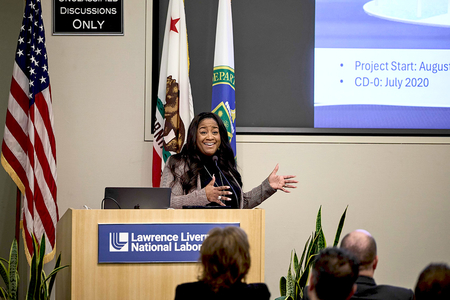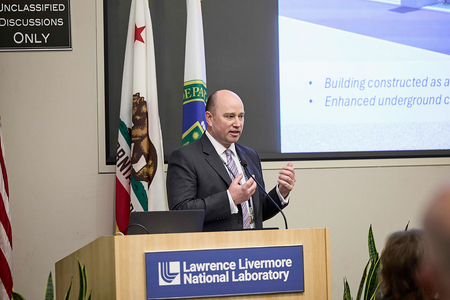Officials with the National Nuclear Security Administration and Lawrence Livermore National Laboratory broke ground Feb. 6 on the Digital Infrastructure Capability Expansion (DICE) project, a critical upgrade for LLNL's networking and communications.
A decade in the making, the 13,000 square-foot facility is scheduled for completion in June 2025. It will provide LLNL with a modern, resilient digital infrastructure to support future technological advancements and the Lab's increasing demands in support of the NNSA's national security mission over the next 40 years.
At the groundbreaking ceremony, LLNL Director Kim Budil recognized the collective effort of NNSA, the Livermore Field Office (LFO) and its partners over the last 10 years to bring the facility to fruition. Budil said DICE will "fulfill an incredibly important capability for the Lab and fill critical gaps in the existing infrastructure." It replaces a pre-Internet networking and communications facility built in 1985, "long before the digital age took flight," she added.
"The needs for digital infrastructure have changed a great deal over that time," Budil said. "Our missions require that this facility not only be scalable and reliable, but agile and modern. We've learned some hard lessons about reliability of infrastructure in the last few years as we work to make this transition on our site. This facility is going to be the main point of entry for all our networking and communications at the Laboratory, so ensuring that we can build it at the right scale, and with the right capabilities, has been an important part of this process."
Budil acknowledged the efforts of various offices within NNSA and close coordination with LFO for the achievement. She also praised the initiatives facilitated by NNSA's new streamlined contracting and procurement processes, which led to a cost savings of $400,000 for the facility.
LLNL's Chief Information Officer Sue Marlais, who introduced the ceremony for the new facility, highlighted the collaboration that culminated in the event, and the impact DICE will have on LLNL's ability to meet its communications needs in the coming decades.
"This groundbreaking event symbolizes not just the physical commencement of a facility, but the realization of a vision that has been carefully nurtured and shaped," Marlais said. "Over the years, this journey has been with challenges, milestones and collective persistence of many. This facility represents more than just an infrastructure - it embodies the promise of enhanced capabilities, efficiency and the digital communication foundation that will support the NNSA mission here at LLNL far into the future."
NNSA officials said the DICE project is evidence of the strides LLNL has made in improving its infrastructure, and epitomizes NNSA's Build SMART initiative, a strategic effort aimed at optimizing planning, execution and delivery of new infrastructure projects to support NNSA's national security missions. The initiative reflects a shift towards more efficient and effective project-management practices, with the acronym underscoring the NNSA's goals of Strategic planning, Mobility, Agility, Risk-informed decision-making and Timely delivery.
NNSA's Associate Administrator for the Office of Infrastructure Nicole Nelson-Jean, who served as field office manager at Livermore when DICE was conceived in 2014, emphasized the critical need for infrastructure improvements - highlighted by past incidents at the Lab, including power outages - and lauded the advancements made at LLNL to address those challenges.
"I am so excited, not just about DICE, but about the progress and all of the things that you have done the last decade to prove your credibility and assurance that you can deliver projects on time, on budget, do such a great job at keeping everyone informed [about] what's happening with those activities and projects, and deliver such fantastic facilities for not just the site, but for the complex," Nelson-Jean said, "It is more than gratifying to stand here and be a part of the groundbreaking for DICE."
NNSA's Associate Administrator for Information Management and Chief Information Officer James Wolff explained how the mission transformation within NNSA is changing the nature of digital infrastructure and its crucial role in mission delivery and discussed ongoing initiatives to modernize IT infrastructure - particularly with the emergence of cloud computing and the increasing amount of data needed for modeling and simulation. He also stressed the importance of collaboration and innovation in addressing critical capability gaps.
"Moving that data around and processing it is a level beyond our capacity to do so right now; but in our field, we must bring that modern capability to these researchers, to the scientists and the engineers, so that they can deliver the best possible performance that they can," Wolff said. "When it comes down to it, you need systems that work when you sit down in front of the machine, and you need it to work perfectly, every single time. For me, that is the most important thing I can provide from an enhancing mission-delivery perspective, and this building is the foundation of it for Lawrence Livermore."
DICE is designed to provide LLNL with state-of-the-art electrical and mechanical capabilities to meet modern digital communications demands and reliability standards. Centrally located on the Lab site, adjacent to the Department of Energy Office of Inspector General building and Exascale Facility Modernization Project, DICE will meet Uptime Institute Tier 3 building standards, providing the facility with "multiple paths of power and cooling," according to LLNL Deputy Director Carolyn Zerkle. The facility includes an enhanced underground cable entrance vault that will integrate into the existing Lab information exchange infrastructure and will be LEED Gold Certified, meeting high-level green building standards, Zerkle added.
Zerkle said the facility represented the convergence of her three passions: construction project management, information technology (IT) and emergency management, and will "bring Livermore's central networking and communications distribution system into the 21st century."
"It was designed to be healthy, highly efficient - with cost savings - and also eco-friendly, which is very important," Zerkle said. "I know we took out a little bit of parking to make this project, but it really will support efficient access to utilities, roads and future site development across the campus. And it will be built to last, which is I think is most important - it will be resilient to power outages and seismic risks that the previous facility wasn't designed to."
LFO Manager Janis Parenti commended the collective efforts of LFO, the Laboratory and NNSA colleagues in the offices of the CIO, Infrastructure and Partnership and Acquisition Services (PAS) in pushing for the DICE project, stating that it had been identified as "one of the top 10 critical facilities on site."
"It took tireless effort to successfully advocate for the importance of this project," Parenti said. "Thanks to that effort on the part of many of you in this room, we will soon have an updated digital infrastructure capable of the expansion needed to support the rapidly evolving NNSA mission."
Speaking on behalf of Pete Rodrik, associate administrator for PAS, Parenti said Rodrik wished to highlight DICE as a prime example of the success of one of NNSA's Enhanced Mission Delivery Initiatives, which focused on a pilot to streamline contracting to deliver construction projects faster. PAS partnered with the NNSA's Office of Infrastructure and the labs, plants and sites, who exchanged lessons learned and best practices to implement the pilot, Parenti explained. DICE represents one of the first line-item projects to benefit from the new pilot program.
Preparations for the DICE construction began in 2019, with the project scheduled for close-out in 2026. Construction will be led by contractor and data center provider PTS Data Center Solutions.










